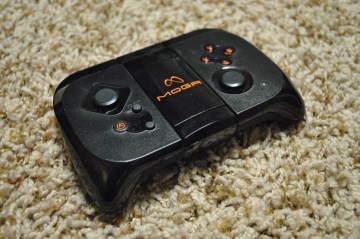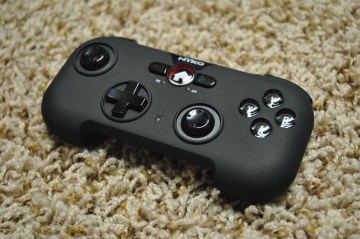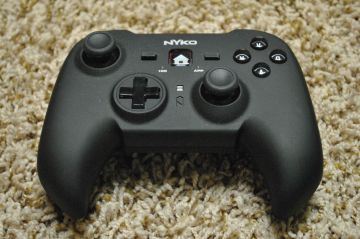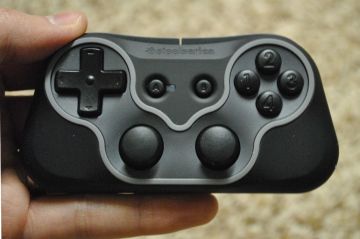Not long ago, serious gamers were practically obligated to turn their noses up at smartphones and tablets. These simple devices, with their touchscreen controls and endless Angry Birds spin-offs, were an affront to the weightier endeavor of shooting aliens and zombies in the face–or so the thinking went.
That’s not really true any more. Sophisticated mobile processors have enabled exactly the kind of games that once seemed only fit for dedicated gaming handhelds, including quick-reflex platformers, third-person adventures and first-person shooters. Because many of these games don’t feel right without real thumbsticks and buttons, a handful of peripheral makers have stepped up with their own Bluetooth game controllers, effectively turning smartphones and tablets into portable video game systems.
I’ve been spending some quality gaming time with four of these phone and tablet game controllers: PowerA’s Moga Mobile Gaming System, SteelSeries’ Free and Nyko’s PlayPad and PlayPad Pro. They’re all aimed primarily at users of Android devices, but all except the Moga have a limited amount of iPhone and iPad support, and can work with Macs or Windows PCs as well.
Here’s what I thought of each one:

Moga Mobile Gaming System ($50)
PowerA’s Moga has a built-in stand that grips your smartphone in place, adding more of a portable gaming device vibe than the other controllers on this list. It connects via Bluetooth to devices running Android 2.3 or higher, and it has its own app that guides you through the setup process and directs you to supported games. Android tablets are supported as well, but you can’t attach them directly to the controller.
The good: The setup process is easy, and the grip is a clever way to combine the phone and controller into a single unit.
The bad: The controller can block access to your phone’s volume controls. The dual sliding analog nubs, while comfortable to grip, aren’t as accurate as proper thumbsticks, and the left nub doesn’t support full 360-degree motion in some games. Also, there’s no D-Pad, and the device relies on two AAA batteries instead of a built-in charger. The biggest problems, though, are the small list of supported games–I count 33 at the moment–and the lack of support for classic game emulators. Broad game support is unlikely because Moga requires developers to program specifically for this controller instead of using the more widely-accepted input methods.
The verdict: If you’re planning to play mostly on a phone, this is a neat option, but only if you’re willing to tinker with the unofficial universal driver, which adds support for lots of other games. Otherwise, prepare to be disappointed by the limited game selection and the cost over time of replacing batteries.

Nyko PlayPad ($40)
The PlayPad has all the inputs you’d expect on a traditional game controller, including two analog nubs, a D-Pad, two trigger buttons and two bumper buttons, and it also has its own carrying case with a stand for propping up larger tablets. Devices running Android 3.0 or higher are supported, and it comes with its own app for setup, though you don’t have to use it.
The good: Between the stand, the carrying case and the full range of controls, the PlayPad offers lots of bang for the buck. Plenty of games and emulators are supported with no setup required beyond Bluetooth pairing.
The bad: The analog nubs are stiff and uncomfortable, and just like the Moga, the left stick only supports eight-directional motion, which is a nuisance for third-person games like Grand Theft Auto III. The Nyko PlayPad app, which lets you map physical controls to games that only offer touch buttons, is still a work in progress; I couldn’t get it to pair with my Nexus 7. Worst of all, when the PlayPad is paired with a phone or tablet, it suppresses the touch screen keyboard, so you must disconnect the controller whenever you need to type.
The verdict: Although the pack-in accessories are a nice touch, the subpar controls make the PlayPad hard to recommend.

Nyko PlayPad Pro ($40)
The Pro version of the PlayPad looks and feels more like a traditional console controller, with full-sized clickable thumbsticks and large grips for each hand, but it doesn’t include a stand or carrying case.
The good: The controller should feel familiar to anyone who owns a Playstation 3 or Xbox 360. Its Windows and Mac compatibility make it a fine PC game controller as well.
The bad: As with the regular PlayPad, the Nyko app is wonky, and the left thumbstick doesn’t do 360-degree motion with games that really need it. This controller also suppresses the touch screen keyboard when connected with your device.
The verdict: For the money, it’s the best Android game controller on this list, even though it’s not as portable as the others.

Steelseries Free ($80)
The Steelseries Free is teeny compared to all the other controllers I tested, measuring shorter and narrower than an iPhone. Still, it manages to include dual thumbsticks, a D-Pad, four face buttons and two bumpers. Best of all, it supports a long list of games with no setup required.
The good: Despite its small size, this controller is surprisingly comfortable. The D-Pad and buttons have just the right amount of rigidity, and the dual thumbsticks provide excellent accuracy for games like Dead Trigger and Shadowgun. And because it’s so small, it could easily fit in a pants pocket along with a smartphone.
The bad: $80 is a steep price to pay for any game controller, let alone one that’s primarily for phones and tablets. Its lack of analog triggers means it won’t do as well doubling as a PC game controller, either.
The verdict: This was without question my favorite controller of the bunch, but the high price makes for a tough sell.
Is Android Ready for Real Gaming?
Keep in mind that using any of these controllers has a bit of an experimental feel to it. There’s no single agreed-upon standard for physical button input across all games, and the Google Play Store doesn’t specifically list supported games. (For that, you’ll want to use the apps or visit the websites of the peripheral makers.) A large part of using these controllers is finding out what works and customizing each game’s button layout to your liking.
Ideally, Google would step in and throw some support behind the idea, giving guidance to both the peripheral makers and the players, but I have no idea whether that would ever happen. For now, these controllers are a good start, and they’ve given me hours of fun with games I skipped when touch controls were the only option. Suddenly, smartphone and tablet gaming doesn’t seem so treacherous.

